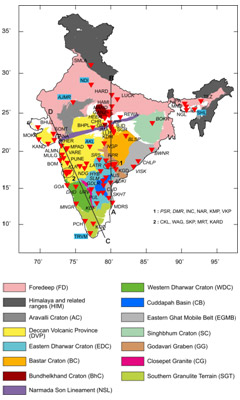Basic Science
| Title | Low shear velocities in the sub-lithospheric mantle beneath the Indian shield? |
|---|---|
| Participants | M. Ravi Kumar, Dipankar Saikia, Arun Singh, D. Srinagesh |
| Sponsoring Agency | CSIR-NGRI |
Work Description:
Ever since its breakup from the Gondwanaland ~140 Myr ago, the Indian plate was ravaged by four hot spots. Although the surface manifestations of such deep processes are evident in terms of large igneous provinces like the Deccan and the fast drift of the Indian plate, the modifications to the deep structure remain to be grasped. In this study, we investigate the mantle transition zone (TZ) structure beneath the Indian shield region using ~14,000 teleseismic receiver functions from 77 broadband stations sited on diverse geologic terrains (Fig. 1.1). The arrival times of the P-to-s (Ps) conversions from the 410 km discontinuity at most cratonic stations appear to be delayed by ~2 s in comparison with the times observed for other Precambrian shield regions like Africa, Australia, and Canada Such delays in the conversions from the 410 km discontinuity below the Indian shield suggest low shear wave speeds in the lithospheric and sub-lithospheric mantles due to higher temperatures, together with a thinner high velocity lid that contrasts with a thicker one found beneath most Archean cratons. A thin transition zone beneath most of the cratonic stations lends support to the enhanced temperatures within the TZ itself. Also, a further delay of the TZ discontinuities is observed for stations on the southern granulite terrain, which was under the influence of the Marion plume that is responsible for the separation of Madagascar from India. Although the data do not conclusively show evidence for a 520 km discontinuity, an LVL atop the 410 cannot be ruled out beneath certain geological provinces of the Indian shield.
 Fig.1.1:
Fig.1.1:
Location of the 77 broadband stations used in this study, superimposed on the surface geology of India. Stations SHL, AKL, and AJMR (labeled in blue) reveal a low velocity layer atop 410. AB and CD are the profiles along which the receiver function sections at individual stations are presented